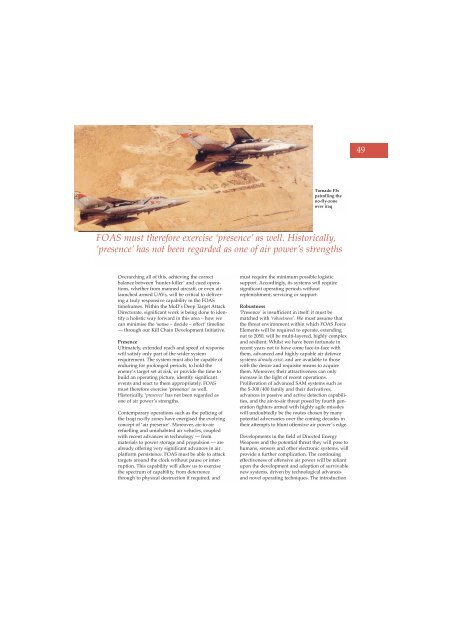Volume 6 No 4 - Royal Air Force Centre for Air Power Studies
Volume 6 No 4 - Royal Air Force Centre for Air Power Studies
Volume 6 No 4 - Royal Air Force Centre for Air Power Studies
You also want an ePaper? Increase the reach of your titles
YUMPU automatically turns print PDFs into web optimized ePapers that Google loves.
49<br />
Tornado F3s<br />
patrolling the<br />
no-fly-zone<br />
over iraq<br />
FOAS must there<strong>for</strong>e exercise ‘presence’ as well. Historically,<br />
‘presence’ has not been regarded as one of air power’s strengths<br />
Overarching all of this, achieving the correct<br />
balance between ‘hunter-killer’ and cued operations,<br />
whether from manned aircraft, or even airlaunched<br />
armed UAVs, will be critical to delivering<br />
a truly responsive capability in the FOAS<br />
timeframes. Within the MoD’s Deep Target Attack<br />
Directorate, significant work is being done to identify<br />
a holistic way <strong>for</strong>ward in this area – how we<br />
can minimise the ‘sense – decide – effect’ timeline<br />
— through our Kill Chain Development Initiative.<br />
Presence<br />
Ultimately, extended reach and speed of response<br />
will satisfy only part of the wider system<br />
requirement. The system must also be capable of<br />
enduring <strong>for</strong> prolonged periods, to hold the<br />
enemy’s target set at risk, or provide the time to<br />
build an operating picture, identify significant<br />
events and react to them appropriately. FOAS<br />
must there<strong>for</strong>e exercise ‘presence’ as well.<br />
Historically, ‘presence’ has not been regarded as<br />
one of air power’s strengths.<br />
Contemporary operations such as the policing of<br />
the Iraqi no-fly zones have energised the evolving<br />
concept of ‘air presence’. Moreover, air-to-air<br />
refuelling and uninhabited air vehicles, coupled<br />
with recent advances in technology — from<br />
materials to power storage and propulsion — are<br />
already offering very significant advances in air<br />
plat<strong>for</strong>m persistence. FOAS must be able to attack<br />
targets around the clock without pause or interruption.<br />
This capability will allow us to exercise<br />
the spectrum of capability, from deterrence<br />
through to physical destruction if required, and<br />
must require the minimum possible logistic<br />
support. Accordingly, its systems will require<br />
significant operating periods without<br />
replenishment, servicing or support.<br />
Robustness<br />
‘Presence’ is insufficient in itself: it must be<br />
matched with ‘robustness’. We must assume that<br />
the threat environment within which FOAS <strong>Force</strong><br />
Elements will be required to operate, extending<br />
out to 2050, will be multi-layered, highly complex<br />
and resilient. Whilst we have been <strong>for</strong>tunate in<br />
recent years not to have come face-to-face with<br />
them, advanced and highly capable air defence<br />
systems already exist, and are available to those<br />
with the desire and requisite means to acquire<br />
them. Moreover, their attractiveness can only<br />
increase in the light of recent operations.<br />
Proliferation of advanced SAM systems such as<br />
the S-300/400 family and their derivatives,<br />
advances in passive and active detection capabilities,<br />
and the air-to-air threat posed by fourth generation<br />
fighters armed with highly agile missiles<br />
will undoubtedly be the routes chosen by many<br />
potential adversaries over the coming decades in<br />
their attempts to blunt offensive air power’s edge.<br />
Developments in the field of Directed Energy<br />
Weapons and the potential threat they will pose to<br />
humans, sensors and other electronic systems, will<br />
provide a further complication. The continuing<br />
effectiveness of offensive air power will be reliant<br />
upon the development and adoption of survivable<br />
new systems, driven by technological advances<br />
and novel operating techniques. The introduction
















